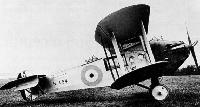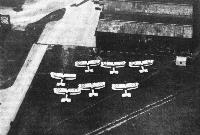
Описание
Страна : Великобритания
Год : 1921
Трех- или четырехместный разведчик-корректировщик для ВМС
Avro серии 555 Bison
В морскую авиацию фирма "Avro" вошла с палубным самолетом серии 555 Bison, спроектированным в соответствии со спецификацией 3/21 на создание корректировщика и разведчика для флота. Первый прототип Bison Mk I поднялся в воздух в 1921 году, затем появилась вторая машина, построенная согласно переработанной спецификации 33/22 и имевшая много доработок. Самой важной из них являлось верхнее крыло, поднятое над фюзеляжем на стойках примерно на 40 см.Третий прототип появился в 1923 году, за ним последовала партия из 12 машин.
Конструкция серийных самолетов по спецификации 16/23 основывалась на втором прототипе. Во флоте они имели обозначение Bison Mk IA. Таких самолетов построили более 35. Все серии 555A использовались под обозначением Bison Mk II, их выпуск прекратили в апреле 1927 года.
Несмотря на то, что самолет изначально создавался как морской, Bison Mk IA сначала поступил в 3-ю эскадрилью британских ВВС, где он заменил Westland Walrus для ведения прибрежной разведки. 423-е звено морских корректировщиков стало первым подразделением авиации ВМС, получившим Bison. Позже эти самолеты приняли на свои палубы авианосцы "Игл" и "Фьюриоус". На берегу Bison эксплуатировался 448-м звеном, дислоцированным в Хал-Фаре, на Мальте. В 1929 году все перечисленные звенья перевооружили на Fairey III.
Первые серийные Bison оснащались одним центральным и двумя подкрыльевыми поплавками плюс убираемыми колесами как у серии 555B, но испытания показали, что такая компоновка является неудовлетворительной.
ТАКТИКО-ТЕХНИЧЕСКИЕ ХАРАКТЕРИСТИКИ
Avro серии 555 Bison Mk I
Тип: трех- или четырехместный разведчик-корректировщик для ВМС
Силовая установка: трехрядный двигатель Napier Lion II мощностью 450 л. с. (336 кВт)
Характеристики: максимальная скорость 177 км/ч на оптимальной высоте; крейсерская скорость 145 км/ч на оптимальной высоте; начальная скороподъемность 183 м/мин; практический потолок 4270 м; дальность полета 547 км
Масса: пустого самолета 1887 кг; максимальная взлетная 2631 кг
Размеры: размах крыла 14,02 м; длина 10,97 м; высота 4,22 м; площадь крыльев 58,53 мг
Вооружение: турельный пулемет калибра 7,7 мм в задней кабине
- Описание
Фотографии
-
Flight 1927-03 / Flight
Avro "Bison" (Napier "Lion"). The Avro "Bison" is a remarkable example of the versatility of the designing powers of a single firm, which has been responsible for such a variety of types as the Avro 504K, the "Avenger" single-seater fighter and the "Ava" bomber. The "Bison" is a four-seater Fleet gunnery spotter. It has a deep fuselage forming a cabin for the crew, while the pilot sits high up in front of the top plane. In spite of its size its landing speed is low enough to permit safe landing on the deck of an aircraft carrier. "Bisons" are attached to H.M.S. Furious and Eagle.
-
Air Pictorial 1956-03 / Photos by request
Регистрационный номер: N154 [2] AVRO BISON I. The prototype Bison I (N154) was designed as a fleet gunnery spolter and appeared at the second (1923) R.A.F. Pageant at Hendon. It was a three/four-seater, with the observer and wireless operator seated in the cabin between the wings, and a gunner in an open cockpit aft. The pilot was situated high up in the fuselage in front of the top wing. A 450-h.p. Napier Lion powered the Bison.
A development, known as the Bison II, was generally similar but was fitted with a fin and had single-bay wings. The span was 46 ft. and the length 37 ft. The Mark II had a maximum speed of 110 m.p.h. and could climb to 10,000 ft. in 24 minutes. Its loaded weight was 5,800 lb. -
Flight 1922-12 / Flight
Регистрационный номер: N153 The Avro "Bison" is a Fleet Gunnery Spotting Aeroplane fitted with Napier "Lion" engine.
-
Мировая Авиация 39
Регистрационный номер: N154 [2] Стойки центроплана подняли верхнее крыло второго прототипа Bison примерно на 0,40 м над фюзеляжем.
-
Air-Britain Aeromilitaria 1978-01
Регистрационный номер: N9601 [2] Bisons in service. Fleet No.39 is N9601 seen taking off from Furious.
-
Air Pictorial 1958-07 / Scrapbook
Регистрационный номер: N9601 [2] FLEET AIR ARM. Photographs of operational aircraft in service with the Fleet Air Arm between the wars are comparatively rare. Reader D. C. McKinnon of Padworth, Berkshire has submitted some fine "action" photographs of which these Avro Type 555 Bison Mk. IIs are but two. The Bison Mk. II was a four-seat deck-landing. Fleet Gunnery Spotter (one 450-h.p. Napier Lion Srs. II). From 1922-7. forty-one Bison Mks. I and II were built. Photo: a Bison Mk. II (N9601) of H.M.S. Courageous, about 1925, fitted with port amidships, gunnery practice sleeve-retrieving windlass.
-
Air-Britain Aeromilitaria 1983-01
Регистрационный номер: N9592 [2] Bison N9592 of No.421B Flight carries 'Eagle's' fuselage band and Fleet Number '34'. Visible in this view are the bomb racks, the open window to the observer's cabin and the flight of steps providing access to the cockpit
-
Aeroplane Monthly 1982-02 / Personal album
Регистрационный номер: N9838 The ugly and aptly named Bison, Avro’s design for a carrier-borne fleet spotter reconnaissance aircraft. Powered by a 450 h.p. Napier Lion, the Bison carried a crew of three or four and was armed with a free-mounted Lewis machine gun on a Scarff ring amidships. Bison N9838 is seen on a flight from Hal Far, Malta in 1928.
-
Air-Britain Aeromilitaria 1978-01
Bisons in service. A Bison target-tug.
-
Air-Britain Aeromilitaria 1983-01
Регистрационный номер: N9848 Bison II N9848, Fleet No. 21, of No.423 Flight is fitted with a fixed Vickers gun for the pilot
-
Flight 1928-05 / Flight
HAMPSHIRE AIR PAGEANT: The Avro "Bison" descending after being defeated by the (distant) Fairey "Flycatcher" in the aerial combat.
Другие самолёты на фотографии: Fairey Flycatcher - Великобритания - 1922
-
Flight 1925-09 / Flight
"BISONS" BROWSING AT BROUGH: This photograph, taken from the air, shows a fleet of Avro "Bison" machines at the Brough aerodrome. The "Bison" was designed and constructed by A. V. Roe and Co. as a Fleet gunnery spotter, and is fitted with a Napier "Lion" engine. The machine is equipped for taking off from, and alighting on, the deck of a vessel.
-
Aeroplane Monthly 1982-10 / P.Capon - Capon's Corner
Регистрационный номер: S1112 Avro Type 555A Bison fleet spotter S1112 was photographed outside the Hamble works in April 1928. The Bison was powered by the 480 h.p. Napier Lion II.
-
Air-Britain Aeromilitaria 1978-01
Регистрационный номер: S1166 Bison II S1166 at Heliopolis in 1929, disembarked from HMS Eagle.
-
Air-Britain Aeromilitaria 1978-01
FLEET AIR ARM. Photographs of operational aircraft in service with the Fleet Air Arm between the wars are comparatively rare. Reader D. C. McKinnon of Padworth, Berkshire has submitted some fine "action" photographs of which these Avro Type 555 Bison Mk. IIs are but two. The Bison Mk. II was a four-seat deck-landing. Fleet Gunnery Spotter (one 450-h.p. Napier Lion Srs. II). From 1922-7. forty-one Bison Mks. I and II were built. Photo: A "runaway", crewless Bison (N959-) about to take the plunge;
-
Air-Britain Aeromilitaria 1978-01
Bisons in service. The Bison IA behind the catch-nets appears to be pilotless
-
Aeroplane Monthly 1982-02 / Personal album
Регистрационный номер: N9592 [2] Another Bison, N9592, was ditched by Lt Harrison with J. Marescaux as his observer. They were picked up by HMS Caradoc. N9592 was originally delivered to the Engine Research Flight at the RAE in February 1924.
-
Мировая Авиация 39
Avro Bison Mk IA
- Фотографии

















